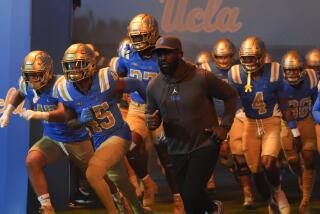The New College Try : Merchandising of Names, Colors and Mascots Is Big Business
- Share via
When Bill Battle coached the University of Tennessee football squad to a Sugar Bowl victory in 1974, avid fans responded by literally painting the town of Knoxville orange.
Today, as the college football season goes into full swing, fans can leave the paintbrushes at home and show their favorite school’s colors with “officially licensed” pompons, beer mugs and a growing assortment of shirts, pants, nightgowns, shorts and caps. For those with more spirit--and cash--there are dozens of other items, including wastebaskets, footlockers, boot jacks, mirrors and toilet seats, all emblazoned with the school’s name, mascot or colors.
Licensed collegiate merchandise has evolved into a big business since Battle’s coaching days, thanks to media exposure that can turn a regional team into a national powerhouse when it comes to sales. Many colleges are following the lead of professional sports franchises, which have turned attractive logos and colors into a major industry.
“Give the (UC Irvine) Anteaters the right logo and colors and they might outsell some of the leaders,” said Paul Much, a Chicago-based sports industry analyst with Houlihan Lokey Howard & Zukin, a consulting firm. “They could become a fashion.”
Americans will spend about $2 billion this year for merchandise bearing college mascots or colors, up from $250 million in 1984, said Battle, now owner and president of an Atlanta company that oversees product licensing for 130 institutions, including the University of Michigan, St. John’s University and the University of Arizona.
That’s dramatic growth from a decade ago, when most college administrators were “nervous about commercializing anything to do with their schools,” Battle said.
A catchy mascot, logo and colors can do wonders for sales of merchandise of professional sports franchises. The San Jose Sharks hockey team, for example, has been woeful on the ice. But its black, white and teal caps and shirts depicting a shark crunching a hockey stick have been a rousing success at the souvenir counter.
Would a college president risk the wrath of well-heeled alumni by tinkering with the mascot and school colors in a bid to make them more marketable?
“Absolutely,” Battle said. “Certainly it will happen in the next 10 years. . . . I’d say it’s likely within the next three years.”
In the early 1980s, only a handful of licensed products-- T-shirts, bumper stickers and beer mugs--were available. Most merchandise was sold through campus bookstores. Today, by contrast, schools such as Texas A&M; deal with nearly 600 licensees who manufacture everything from candy bars and glassware to golf balls and clocks.
Most college merchandise is now sold through sporting goods, department and retail stores. In 1984, Atlanta-area retailers stocked little in the way of local college items. Today, Battle said, “you can find stuff from 20, 30, even 40 different schools in any mall you go into.”
Upward of 300 institutions of higher learning have licensed manufacturers to make merchandise bearing their “marks,” according to the National Assn. of College Stores.
A handful of colleges have set up outlets in shopping malls. USC, for example, last week opened its first off-campus location, a store at South Coast Plaza’s Crystal Court in Costa Mesa. The store, to remain open through the holidays, is designed to sate even the most rah-rah alums with “every type of merchandise imaginable,” merchandise buyer Dan Stimmler said.
UCLA in May opened UCLA Spirit, a gift shop at Universal Citywalk. The 1,650-square-foot store offers a wide variety of products emblazoned with UCLA’s colors, logo and name.
Colleges that properly promote and police their marks can earn several million dollars annually in licensing fees, Battle said. But only a handful of universities--such as Michigan, Georgetown University and the University of Miami--have reached that pinnacle.
Not surprisingly, collegiate sales are driven by success on the athletic field and arena.
“Kids like the ‘winning team’ aspect, but they also are picking up on licensed apparel as a fashion statement,” Much said. “Yes, you see a lot of Chicago Bulls because they won, but kids also are drawn by the colors and the logo.”
Established universities will give their loyal alumni the traditional colors and designs, Much said. “But you might see a new line of flashier things for the kids who want to make a fashion statement.”
More to Read
Go beyond the scoreboard
Get the latest on L.A.'s teams in the daily Sports Report newsletter.
You may occasionally receive promotional content from the Los Angeles Times.










